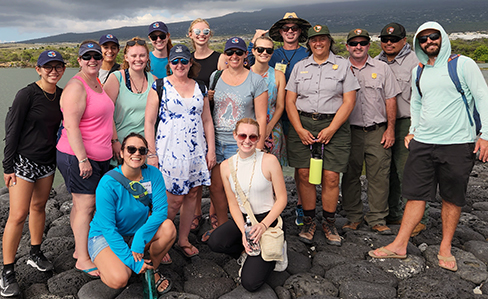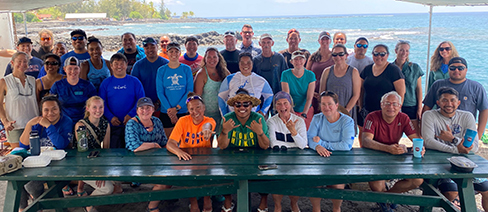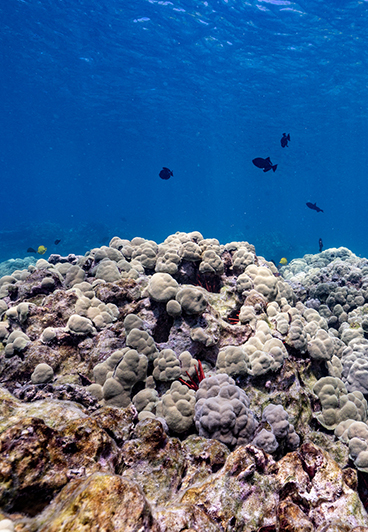- ABOUT US
- PROGRAM AREAS
- CONSERVATION APPROACH
- EDUCATION
- MULTIMEDIA
Adventures of the U.S. Coral Reef Task Force in Hawai'i
Recently, The US Coral Reef Task Force hosted its first in-person meeting since 2019 in Kona, Hawai'i. The week was filled to the brim with educational and inspired conversations around coral reef conservation. Participants had the opportunity to explore efforts to protect coral reefs in beautiful Hawai'i on site visits that were organized by the local planning team. Some locations were the Kaloko-Honokōhau National Historical Park, Miloli'i Community-Based Subsistence Fishing Area, the South Kohala Watershed, and Kealakekua Bay. Read on for more!
Kaloko-Honokōhau National Historical Park
Kaloko-Honokōhau National Historical Park is the site of the ancient Hawaiian settlement Honokōhau and includes the coastal portions of five traditional land divisions or ahupua'a. The Park is one of four Pacific Islands national park units containing coral reefs.
National Park Service staff provided a tour of the park, which gave us the opportunity to view traditional Hawaiian fish ponds (Loko i'a) and the seawall (kuapā) to learn about Hawaiian aquaculture. Following the fish pond, we went for a short hike to observe the unique environments called anchialine ponds which contain native 'ōpae'ula (red shrimp, Halocaridina rubra), a critical biocultural resource for traditional Hawaiian fishing methods. Community members, whose families have been fishing this area for generations, explained the importance of these traditions.

Miloli'i Community-Based Subsistence Fishing Area
The Village of Miloli'i recently received the designation of Community Based Subsistence Fishing Area (CBSFA). This designation highlights the traditional Hawaiian fishing practices, community sharing, and restoring fisheries to preserve for future generations. We visited the Village of Miloli'i, interacted with the community, explored the fishery by boat and snorkeling, and got an on-the-ground look into the community-based fisheries management practices used within the fisheries of Miloli'i.

South Kohala Watershed
We were also invited to explore a priority area called South Kohala Watershed. South Kohala was made a priority watershed in order to reduce threats of land-based sources of pollutants (LBSP) to coral reefs by implementing best management practices to restore the watershed.
Participants visited Pu'ukoholā Heiau National Historic Site Visitor Center, interacted with staff and local partners, and discussed watershed uses, successes, and challenges. Watershed Working Groups members were excited to go for a quick snorkel and tour the Pelekane watershed restoration site where best management efforts are addressing erosion and runoff issues.

Kealakekua Bay Snorkel
In 2015, coral reefs all across Hawai'i suffered from severe coral bleaching. One of these reefs is located in Kealakekua Bay located in Kona, Hawai'i. This bay is historically famous because it is where European explorer, Captain James Cook, landed, explored, and later died. Kealakekua Bay was established as a Marine Life Conservation District (MLCD) in 1973. It is well studied by researchers and managers.
U.S. Coral Reef Task Force members were able to snorkel key sites within Kealakekua Bay and learn from State of Hawai'i Division of Aquatic Resources biologists about the important research and restoration efforts happening in the bay. Snorkelers saw beautiful tropical coral reefs, octopus, moray eels, tropical fish, the invasive crown-of-thorns starfish, and a sea turtle sighting (which is rare for this bay).
Related Stories and Products
About Us

The NOAA Coral Reef Conservation Program was established in 2000 by the Coral Reef Conservation Act. Headquartered in Silver Spring, Maryland, the program is part of NOAA's Office for Coastal Management.

The Coral Reef Information System (CoRIS) is the program's information portal that provides access to NOAA coral reef data and products.
Work With US
U.S. Coral Reef Task Force
Funding Opportunities
Employment
Fellowship Program
Contracting Assistance
Graphic Identifier
Featured Stories Archive

Access the archive of featured stories here...
Feedback
Thank you for visiting NOAA’s Coral Reef Conservation Program online. Please take our website satisfaction survey. We welcome your ideas, comments, and feedback. Questions? Email coralreef@noaa.gov.
Stay Connected
Contact Us
NOAA’s Coral Reef Conservation Program
SSMC4, 10th Floor
1305 East West Highway
Silver Spring, MD 20910
coralreef@noaa.gov
